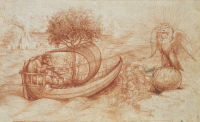Imagination and Invention Click on the thumbnails to explore the trail
Read more about this trail (expand)
The exercise of imaginative fantasy was as much an integral part of Leonardo’s mind as the discipline of scientific observation. For the artist, imagination was dependent upon an accurate understanding of observational input – a complete comprehension of the geometry of God’s design. Sensory impressions gained from observation were recombined by the artist’s ‘fantasia’ or imagination, to create new and credible forms

- Enlarge
- Zoom & explore
- The Royal Collection © 2005, Her Majesty Queen Elizabeth II
Allegory with a wolf and an eagle c1516
Leonardo’s artistic imagination and skill made him a master of allegories. These visual puns were a great source of amusement during the Renaissance. The more complex the better, which means that today their precise meaning is often difficult to decipher.
In this highly finished red chalk drawing, a wolf at the helm of a boat approaches a shore where a crowned eagle is perched on a globe of the world. While the seas between the boat and the shore are stormy, beyond in the distance all is calm. The wolf, which has a semi-human body, sets his sights on his destination with a compass in one paw and the other on the tiller. The mast of his boat is an olive tree in full leaf, which supports a full-blown sail.
What does it all mean? Given that the wolf is an allegory of the Pope and the eagle of the King of France, it seems likely that Leonardo’s drawing is an allegory of the peace treaty signed by both the King and the Pope in December 1515. The olive-tree is of course a symbol of peace.
In Leoanrdo's words
...il Moro (Ludovico Sforza) representing Good Fortune, with hair, robes, and his hands in front…Poverty, in a hideous form running behind a youth. Il Moro covers him with the skirt of his robe, and with his gilt sceptre he threatens the monster…grass with its roots in the air to represent one who is near the end of his good and favour.
In this highly finished drawing, Leonardo conjures up a composition entirely from the imagination to create a charming enigmatic allegory the meaning of which is not entirely clear.
A wolf is seated in the stern of a boat, the mast of which is a growing olive tree, with a compass in his right paw and his left on the tiller. The compass is pointing straight at an eagle, which is perched on a globe on the shore.
The subject has been variously interpreted, but the most likely reading is an allegory of the Papacy. The wolf was a traditional symbol of the pope, while the eagle on a globe of the earth is thought to symbolise the political aspirations of the King of France. The olive tree traditionally represents peace. It therefore seems likely that the allegory refers to an alliance made between Pope Leo X and Francis I in December 1515.
- Medium Red chalk
- Size 17 x 28 cm
- Location The Royal Collection










